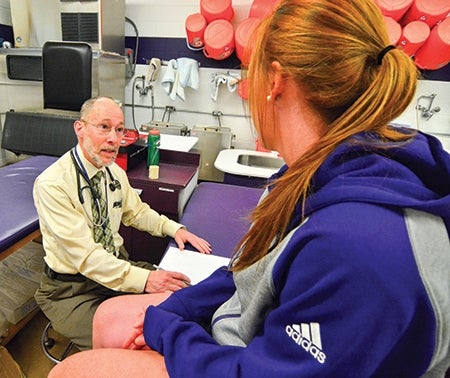Protecting young athletes from the opioid crisis
 Edd Cote
Dr. Jay Broadhurst works with College of the Holy Cross senior Emily Jarvis. Broadhurst said his experience working with people suffering from opiate addiction at Spectrum Health Systems has allowed him to have honest conversations about substance abuse with the athletes he treats.
Edd Cote
Dr. Jay Broadhurst works with College of the Holy Cross senior Emily Jarvis. Broadhurst said his experience working with people suffering from opiate addiction at Spectrum Health Systems has allowed him to have honest conversations about substance abuse with the athletes he treats.
At the College of the Holy Cross, Dr. Jay Broadhurst is one of the team physicians for the athletics department. He also works as an addiction specialist at Worcester-based Spectrum Health Systems, among other jobs.
This expertise in treating addiction has helped him to address the elephant in the room with injured student-athletes.“I say, with a wink, ‘come to me if you want to get that heroin problem under control.’” he said. “I’m not frightened to talk about it, and sometimes athletes will come, and they will share a concern, about themselves or a teammate.”
These conversations are an important way to open up communication between the sports medicine staff and the students about the touchy subject of opiate addiction, Broadhurst said. It opens the possibility for a peek into the lives of students, so the training staff can help out if there’s a problem, he said.
The opiate crisis has led to an increased awareness of how narcotics are prescribed for acute pain relief, including among doctors who treat people for sports-related injuries.
A new law signed by Gov. Charlie Baker in March limits first time opioid prescriptions to a seven-day supply, increases the regularity of substance abuse screening in middle and high school students, and gives patients the ability to request that a doctor prescribe less than the standard number of opioid pills. It also allows patients to ask pharmacists to underfill a prescription for opiates if that’s what they want.
The law has added to the already heightened awareness from the medical community surrounding how opiates are prescribed, and how they are discussed with patients.
The fifth vital sign
When it comes to treating pain with opiates, the pendulum has swung heavily in both directions since the early 1970s, said Dr. Dennis Dimitri, outgoing president of the Massachusetts Medical Society. Speaking to a crowd at a panel on the opiate crisis held in early June at the Beechwood Hotel in Worcester, Dimitri said the establishment of the Drug Enforcement Agency by President Richard Nixon in 1973 made many doctors hesitant to prescribe opiates, even in situations where it might have been appropriate to do so.
“[Doctors] thought the DEA was going to show up at their office and take away their license to practice medicine. So the pendulum swung way too far,” he said. “Many of us have heard the anecdote of dying cancer patients being told by their doctors, ‘sorry, I won’t prescribe any morphine for you because I’m afraid I’ll turn you into an addict.’ That was silliness at the far end of the pendulum.”
But then in the late 1990s, the attitude towards opiates did a 180. Pain became known as the fifth “vital sign,” and hospitals and doctors were graded on whether or not they provided relief to their patients. At the same time, chronic pain experts started teaching physicians that it was safe to use opioids for patients who were suffering from chronic non-malignant pain.
“Physicians ...were frankly duped by drug manufacturers who said these drugs can be used safely in ever-increasing amounts. So, doctors were trying to do the right thing by their patients and I think got caught in a perfect storm that put us in a very difficult position,” Dimitri said.
Opiates have been over-prescribed over the last 10 to 15 years, Dimitri said.
“Now we’re in a situation where we need to help people transition off of these medications into other modalities for pain medication,” said Dr. Erik Garcia, a doctor with UMass Memorial Community HealthLink, the behavioral health arm of UMass Memorial Medical Center.
And this isn’t to say opiates aren’t effective tools in certain situations -- they are, doctors said. They can be very helpful when used as treatments for acute pain in moderation. Doctors are now more conscious of checking for potential risk factors and monitoring patients for addiction risk factors.
“If you have someone who has an acute pain from injury, or comes into the hospital in the emergency room, or certainly after an operation, opioids … are effective, they act quickly, they really help pain. The only thing that we are cautious about is making sure we assess the need for these medications, and that we appropriately treat them with the target of relieving pain,” said Dr. Maria Garcia, medical director of the University of Massachusetts Medical School’s Clinical Pharmacy Services.
But their use as a treatment of chronic pain was misguided, she said.
“In terms of management of long-term chronic pain, the evidence is lacking for opioids being on the forefront in treatment,” Maria Garcia said.
Sports injury a potential gateway?
For many patients, a sports-related injury spurred an introduction to opiates. About 80 percent of people who check into a drug rehabilitation center for opiate treatment first were exposed to the drug through a prescription, not on the street, Dimitri said.
An article published on the website of the The National Collegiate Athletic Association (NCAA) last year said that college athletes, who are at high risk for acute pain from injuries, binge drink more frequently than their non-athletic counterparts, and combining alcohol with a prescription opiate greatly increases the risk of accidental overdose and death.
The NCAA’s most recent substance abuse survey from 2014 found that about 23 percent of student athletes reported using pain medication in the past year, and that six percent of student athletes used an opioid without a prescription over the same time period.
According to the NCAA’s website, doctors treating student athletes should avoid prescribing opiates whenever possible and if the situation calls for it, they should explain that opiates are only supposed to be used for a short period of time.
At Holy Cross, Broadhurst said he almost never prescribes opiates, and would be surprised if he wrote a narcotics prescription at any point over the last 10 years. Athletes who have to go in for surgery are sometimes prescribed opiates by the surgeons, under the watchful eye of the College, he said.
“If I have a patient in my practice in Shrewsbury that has a surgical procedure, I might see them once a week. At Holy Cross, if they have a surgical procedure and they come back to campus, that athletic trainer is seeing them every day,” he said. “You can mitigate the risk associated with narcotic medication because you have a trained person in the form of an athletics trainer who is going to see them on a daily basis.”
Athletes may be at a greater risk for injury, but when it comes to addiction, opiates do not discriminate, doctors said. Everyone, regardless of age, race, or social standing, is at risk.
“When I admit people to opiate dependence treatment, I’m thinking, ‘gosh this is an equal opportunity disease. It doesn’t discriminate,” broadhurst said. “Including physicians, including athletes. The fact that I’ve got ‘M.D.’ after my name doesn’t inoculate me from the disease.”
Read other Central Massachusetts HEALTH stories:
- Tobacco age hikes spread but are teens safe?
- Spectrum’s retiring CEO Faris pioneered compassionate care for opiate addiction
- C-sections on trial
- Worcester sports medicine specialist talks treating stars
- Simple improvements count for healthcare innovation too
- Tips for choosing a pediatrician
- Why offer mental health services at work?
WBJ Web Partners
Virtually all opioids are effective for treatment of pain syndromes but also can cause addiction.
There is an opioid in clinical trials which is also effective for pain but has no addiction potential!
If it passes the current trials doctors will have a non addictive opioid pain medication to prescribe.













1 Comments